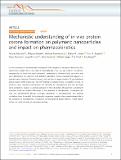| dc.contributor.author | Grenier, Philippe | |
| dc.contributor.author | Mahmoudi, Morteza | |
| dc.contributor.author | Appel, Eric A. | |
| dc.contributor.author | Lim, Jong-Min | |
| dc.contributor.author | Karnik, Rohit | |
| dc.contributor.author | Farokhzad, Omid C. | |
| dc.contributor.author | Bertrand, Nicolas | |
| dc.contributor.author | Martins Lima, Eliana | |
| dc.contributor.author | Dormont, Flavio | |
| dc.contributor.author | Langer, Robert S | |
| dc.date.accessioned | 2018-05-02T19:33:09Z | |
| dc.date.available | 2018-05-02T19:33:09Z | |
| dc.date.issued | 2017-10 | |
| dc.date.submitted | 2017-03 | |
| dc.identifier.issn | 2041-1723 | |
| dc.identifier.uri | http://hdl.handle.net/1721.1/115195 | |
| dc.description.abstract | In vitro incubation of nanomaterials with plasma offer insights on biological interactions, but cannot fully explain the in vivo fate of nanomaterials. Here, we use a library of polymer nanoparticles to show how physicochemical characteristics influence blood circulation and early distribution. For particles with different diameters, surface hydrophilicity appears to mediate early clearance. Densities above a critical value of approximately 20 poly(ethylene glycol) chains (MW 5 kDa) per 100 nm 2 prolong circulation times, irrespective of size. In knockout mice, clearance mechanisms are identified for nanoparticles with low and high steric protection. Studies in animals deficient in the C3 protein showed that complement activation could not explain differences in the clearance of nanoparticles. In nanoparticles with low poly(ethylene glycol) coverage, adsorption of apolipoproteins can prolong circulation times. In parallel, the low-density-lipoprotein receptor plays a predominant role in the clearance of nanoparticles, irrespective of poly(ethylene glycol) density. These results further our understanding of nanopharmacology. | en_US |
| dc.publisher | Nature Publishing Group | en_US |
| dc.relation.isversionof | http://dx.doi.org/10.1038/S41467-017-00600-W | en_US |
| dc.rights | Attribution 4.0 International (CC BY 4.0) | en_US |
| dc.rights.uri | https://creativecommons.org/licenses/by/4.0/ | en_US |
| dc.source | Nature Communications | en_US |
| dc.title | Mechanistic understanding of in vivo protein corona formation on polymeric nanoparticles and impact on pharmacokinetics | en_US |
| dc.type | Article | en_US |
| dc.identifier.citation | Bertrand, Nicolas et al. “Mechanistic Understanding of in Vivo Protein Corona Formation on Polymeric Nanoparticles and Impact on Pharmacokinetics.” Nature Communications 8, 1 (October 2017): 777 © 2017 The Author(s) | en_US |
| dc.contributor.department | Harvard University--MIT Division of Health Sciences and Technology | en_US |
| dc.contributor.department | Massachusetts Institute of Technology. Department of Chemical Engineering | en_US |
| dc.contributor.department | Koch Institute for Integrative Cancer Research at MIT | en_US |
| dc.contributor.mitauthor | Bertrand, Nicolas | |
| dc.contributor.mitauthor | Martins Lima, Eliana | |
| dc.contributor.mitauthor | Dormont, Flavio | |
| dc.contributor.mitauthor | Langer, Robert S | |
| dc.relation.journal | Nature Communications | en_US |
| dc.eprint.version | Final published version | en_US |
| dc.type.uri | http://purl.org/eprint/type/JournalArticle | en_US |
| eprint.status | http://purl.org/eprint/status/PeerReviewed | en_US |
| dc.date.updated | 2018-04-27T14:29:28Z | |
| dspace.orderedauthors | Bertrand, Nicolas; Grenier, Philippe; Mahmoudi, Morteza; Lima, Eliana M.; Appel, Eric A.; Dormont, Flavio; Lim, Jong-Min; Karnik, Rohit; Langer, Robert; Farokhzad, Omid C. | en_US |
| dspace.embargo.terms | N | en_US |
| dc.identifier.orcid | https://orcid.org/0000-0003-4255-0492 | |
| mit.license | PUBLISHER_CC | en_US |
